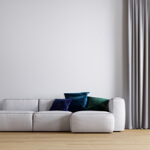Alan Davie 1920-2014
Woman bewitched by the Moon, no.3, 1956
Oil on board
130 x 100 cms
51 2/16 x 39 5/16 ins
51 2/16 x 39 5/16 ins
2038
Sold
Woman Bewitched by the Moon was painted at one of the most crucial moments in the artist's development. In 1956, Davie exhibited in New York for the first time, where...
Woman Bewitched by the Moon was painted at one of the most crucial moments in the artist's development. In 1956, Davie exhibited in New York for the first time, where his work was acquired by major collections such as the Museum of Modern Art. While there Davie met many of the most important artists of the New York School, including Jackson Pollock and Willem de Kooning.
At this time Davie frequently worked on one-off statements but he did also do two small groups of works on specific themes, Image of the Fish God and Woman Bewitched by the Moon, which are considered to be amongst his most important early works and which are certainly amongst the most powerful twentieth century British art of the second half of the twentieth century. With reference to paintings of this period, Davie has written of his motivations and procedures as a painter: ideas and forms come intuitively out of the act of painting: driven by an intense inner urge to create without specific pre-conceived formal concept. On the whole colours were randomly spread onto the board and black was generally used to draw forms within the colour areas and then often the emerging suggestions of form were accentuated and made firmer with the addition of more colour - ' a marriage of line and colour area' I am then faced with the totally 'unknown' image, which acts as a revelation of something hidden, but somehow recognized as having a great significance... occurs, it seems, a kind of ecstatic vision - which might be possibly some kind of RELIGIOUS revelation? That is, out of a timeless sphere, beyond conceiving. I have actually written on some works: IMAGES ARE NOT MADE AS ART OBJECTS BUT AS CHANNELS of COMMUNION WITH THE DIVINE' Spatially the painting suggests the legacy of Cubism. In Davie's greatest paintings of the mid 1950s, as in Cubism, there is immense sophistication in the orchestration of space and a masterly application of paint that allows the artist to retain a grip on subject matter whilst retaining maximum expressive freedom. As Patrick Heron observed at the time: in its love of the concrete, extols paint, canvas, paper, chalk as well as wine-glasses, tables and guitars. This sensuous love of the material is of paramount importance to Soulages, de Stael and -over here in England - to William Scott, Alan Davie, Roger Hilton, Peter Lanyon, Victor Pasmore and Terry Frost.' 'Space in Contemporary Painting and Architecture in Patrick Heron', The Changing Forms of Art (Routlege and Kegan Paul, London, 1955). Nonetheless, it is with contemporary American painting that Davie's work of this period can often most appropriately be compared. Snail Elements may be compared not only to the all-over handling to be found in the drip paintings of Jackson Pollock but also to the types of embedded imagery and Jungian symbols to be found in his major paintings of the 1940s. Furthemore, Snail Elements also recalls the spatial sophistication of de Kooning's paintings with their embedded imagery. Another painting from this group is held by the Scottish National Gallery of Modern Art in Edinburgh.
At this time Davie frequently worked on one-off statements but he did also do two small groups of works on specific themes, Image of the Fish God and Woman Bewitched by the Moon, which are considered to be amongst his most important early works and which are certainly amongst the most powerful twentieth century British art of the second half of the twentieth century. With reference to paintings of this period, Davie has written of his motivations and procedures as a painter: ideas and forms come intuitively out of the act of painting: driven by an intense inner urge to create without specific pre-conceived formal concept. On the whole colours were randomly spread onto the board and black was generally used to draw forms within the colour areas and then often the emerging suggestions of form were accentuated and made firmer with the addition of more colour - ' a marriage of line and colour area' I am then faced with the totally 'unknown' image, which acts as a revelation of something hidden, but somehow recognized as having a great significance... occurs, it seems, a kind of ecstatic vision - which might be possibly some kind of RELIGIOUS revelation? That is, out of a timeless sphere, beyond conceiving. I have actually written on some works: IMAGES ARE NOT MADE AS ART OBJECTS BUT AS CHANNELS of COMMUNION WITH THE DIVINE' Spatially the painting suggests the legacy of Cubism. In Davie's greatest paintings of the mid 1950s, as in Cubism, there is immense sophistication in the orchestration of space and a masterly application of paint that allows the artist to retain a grip on subject matter whilst retaining maximum expressive freedom. As Patrick Heron observed at the time: in its love of the concrete, extols paint, canvas, paper, chalk as well as wine-glasses, tables and guitars. This sensuous love of the material is of paramount importance to Soulages, de Stael and -over here in England - to William Scott, Alan Davie, Roger Hilton, Peter Lanyon, Victor Pasmore and Terry Frost.' 'Space in Contemporary Painting and Architecture in Patrick Heron', The Changing Forms of Art (Routlege and Kegan Paul, London, 1955). Nonetheless, it is with contemporary American painting that Davie's work of this period can often most appropriately be compared. Snail Elements may be compared not only to the all-over handling to be found in the drip paintings of Jackson Pollock but also to the types of embedded imagery and Jungian symbols to be found in his major paintings of the 1940s. Furthemore, Snail Elements also recalls the spatial sophistication of de Kooning's paintings with their embedded imagery. Another painting from this group is held by the Scottish National Gallery of Modern Art in Edinburgh.


